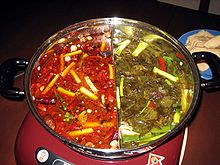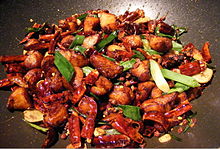- Szechuan cuisine
-

This article is part of the series Chinese cuisine Regional cuisinesFour Great Traditions
Cantonese • Huaiyang • Shandong • Sichuan
Eight Great Traditions
Anhui • Cantonese • Fujian • Hunan • Jiangsu • Shandong • Sichuan • ZhejiangBeijing and the vicinity
Beijing • Imperial • Aristocrat • TianjinOther regional styles
Chaozhou • Guizhou • Hainan • Hakka • Henan • Hong Kong • Hubei • Jiangxi • Macanese • Manchu • Northeastern • Shaanxi • Shanghai • Shanxi • Taiwanese • Xinjiang • Tibetan (Xizang) • YunnanReligious cuisinesBuddhist • IslamicIngredients and types of food China portal
China portalSzechuan cuisine, Sichuan cuisine, or Szechwan cuisine (Chinese: 四川菜; pinyin: Sichuancai or Chinese: 川菜; pinyin: chuancai) is a style of Chinese cuisine originating in the Sichuan Province of southwestern China famed for bold flavors, particularly the pungency and spiciness resulting from liberal use of garlic and chili peppers, as well as the unique flavour of the Sichuan peppercorn (花椒). Peanuts, sesame paste, and ginger are also prominent ingredients in Szechuan cooking.[1] Although the region is now romanized as Sichuan, the cuisine is still often spelled Szechuan or Szechwan in North America. There are many local variations of Sichuan cuisine within Sichuan Province and the Chongqing Municipality, which was politically part of Sichuan until 1997. The four best known regional sub-styles are Chongqing style, Chengdu style, Zigong style, and Buddhist vegetarian style.[1] UNESCO has declared the city of Chengdu to be a city of Gastronomy in 2011, mainly because of its Szechuan style of cooking.[2]
Contents
History
Sichuan cuisine originating from Sichuan, China is sometimes known as "heavenly country" due to its abundance of food and natural resources. Based on at least one ancient Chinese account, "people of Sichuan uphold good flavor, and they are fond of hot and spicy taste."[3] Despite Sichuan cuisine reputation as being spicy, only a small portion of the food is spicy and according to at least one Chinese culinary writer the Sichuan cuisine is composed of seven basic flavors: Sour, pungent, hot, sweet, bitter, aromatic, and salty. Generally throughout its history, there have been five different type of Sichuan foods: Sumptuous banquet, ordinary banquet, popularized food, home-style food, and food snacks. Sichuan cuisine has changed little over the years and remains a staple of Chinese cuisine.[3]
Preparations
Szechuan cuisine often contains food preserved through pickling, salting, and drying and is generally spicy due to heavy application of chilli oil. The Sichuan peppercorn huājiāo 花椒 ('flower pepper') is commonly used. Szechuan pepper has an intensely fragrant, citrus-like flavour and produces a "tingly-numbing" (Chinese: 麻) sensation in the mouth. Also common are garlic, chili, ginger, star anise and other spicy herbs, plants and spices. Broad bean chili paste (simplified Chinese: 豆瓣酱; traditional Chinese: 豆瓣醬; pinyin: dòubànjiàng) is also a staple seasoning in Sichuan cuisine. The region's cuisine has also been the originator of several prominent sauces widely used in Chinese cuisine as a whole today, including yuxiang (魚香), mala (麻辣), and guaiwei (怪味).
Common preparation techniques in Szechuan cuisine include stir frying, steaming and braising, but a complete list would include more than 20 distinct techniques. Beef is somewhat more common in Szechuan cuisine than it is in other Chinese cuisines, perhaps due to the prevalence of oxen in the region.[4] Stir-fried beef is often cooked until chewy, while steamed beef is sometimes coated with rice flour to produce a very rich gravy. Sichuan cuisine also utilizes various bovine and porcine organs as ingredients such as intestine, arteries, the head, tongue, skin, and liver in addition to other commonly utilized portions of the meat.
Representative dishes
Some well-known Szechuan dishes include Gongbao or Kung Pao chicken[1] and Twice Cooked Pork. Although many dishes live up to their spicy reputation, often ignored are the large percentage of recipes that use little or no hot spices at all, including dishes such as Tea Smoked Duck.
In the following table, if there is a difference between the two, simplified Chinese will be presented first, followed by traditional Chinese, and finally pinyin.
English Literal meaning (if not implied in the English name) Chinese Kung Pao chicken 宫保鸡丁/宮保雞丁 (gōngbǎo jīdīng) Tea smoked duck 樟茶鸭/樟茶鴨 (zhāngchá yā) Twice cooked pork 回锅肉/回鍋肉 (huíguōròu) Mapo dofu 麻婆豆腐 (mápó dòufǔ) Sichuan hotpot 四川火锅/四川火鍋 (Sìchuān huǒguō) Fuqi Feipian Cold Beef Tripe 夫妻肺片 (fūqī fèipiàn) Spicy deep-fried chicken 辣子鸡/辣子雞 (làzǐjī) Shuizhu dishes Water cooked dishes 水煮 (shuǐzhǔ) Dan dan noodles 担担面/擔擔麵 (dàndàn miàn) Bon bon chicken 棒棒鸡/棒棒雞 (Bàngbàng jī) See also
- Chinese cuisine
- Hunan cuisine
- List of Chinese Cuisine Names
- Chen Kenmin
- List of Chinese dishes
- Cooking
- Chinatown, Flushing
References
- ^ a b c Marshall Cavendish Corporation (2007). World and Its Peoples: Eastern and Southern Asia. Marshall Cavendish. pp. 126. http://books.google.com/books?id=cKh2KL5LqEsC&pg=PA126&dq=szechuan+cuisine#v=onepage&q=szechuan%20cuisine&f=false.
- ^ UNESCO (2011). "Chengdu: UNESCO City of Gastronomy". UNESCO. http://unesdoc.unesco.org/Ulis/cgi-bin/ulis.pl?catno=192047&set=4DA7AA10_2_364&gp=&lin=1&ll=1. Retrieved May 26, 2011.
- ^ a b 傅培梅 (2005). Mei Pei Featured Dishes (CH: 培梅名菜精選: 川浙菜專輯). 橘子文化事業有限公司. p. 9. http://books.google.com/books?id=dAe9waoP0NYC&pg=PA9&dq=sichuan+cuisine#v=onepage&q=sichuan%20cuisine&f=false.
- ^ Tropp, Barbara (1982). The Modern Art of Chinese Cooking. New York: Hearst Books. pp. 183. ISBN 0-688-14611-2.
External links
Sichuan cuisine Ants climbing a tree · Dan dan noodles · Doubanjiang · Fuqi feipian · Guaiwei · Guoba · Hot and sour soup · Hot pot · Kung Pao chicken · Mala sauce · Mapo doufu · Pao cai · Shuizhu · Sichuan pepper · Suanla chaoshou · Tuotuorou · Twice cooked pork · Wonton · Wuliangye Yibin · Yuxiang · Zha cai · Zhangcha duckSichuan topics General History NationsBa & Shu · Chengjia · Shu Han · Cheng Han · Western Shu · Former Shu · Later Shu · Great Shu · Great Xia · Great XiEventsSichuan-Mongol War · Huguang Filling Sichuan · Railway Protection Movement · Home Front PeriodGeography Cities • Sichuan Basin • Chengdu Plain • Regions (West • East • North • South) • Rivers (Sichuan • Min • Jialing • Tuo • Yalong) • Mountain ranges (Daba • Longmen • Qionglai • Hengduan )Culture People Languages Visitor attractions Categories:- Regional cuisines of China
- Sichuan
- Sichuan cuisine
Wikimedia Foundation. 2010.



